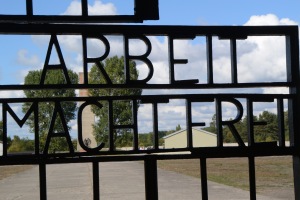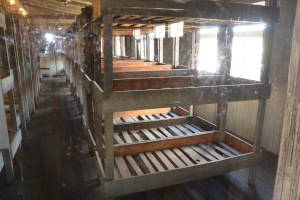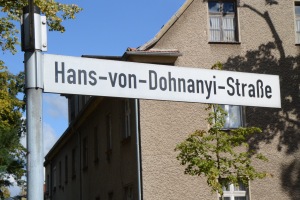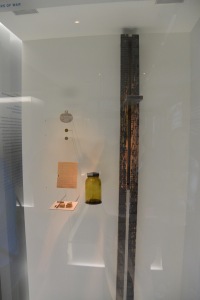 Sachsenhausen Concentration Camp is located in northern suburban Berlin. I took a tour led by Jamie, a British archeologist who was incredibly knowledgeable about the rise of the Nazi state, and about this camp in particular. Our group, made up of Brits, Canadians and Americans, met at an S-Bahn stop near my hotel. We got off the S-Bahn some distance from the camp and walked, including along Hans von Dohnyani Strasse. He was Bonhoeffer’s brother-in-law who was executed at Sachsenhausen.
Sachsenhausen Concentration Camp is located in northern suburban Berlin. I took a tour led by Jamie, a British archeologist who was incredibly knowledgeable about the rise of the Nazi state, and about this camp in particular. Our group, made up of Brits, Canadians and Americans, met at an S-Bahn stop near my hotel. We got off the S-Bahn some distance from the camp and walked, including along Hans von Dohnyani Strasse. He was Bonhoeffer’s brother-in-law who was executed at Sachsenhausen.
Sachsenhausen was not an extermination camp although many people died there. The crematoria were quite busy, and human ash fell on the cute bungalows of the SS officers’ families located just outside the gates. The phrase, “Albeit mach Frei” means, “Work Will Free You.” Old prisoners, called kapos, reminded the newcomers that there was one way to freedom – up the chimneys.
The absolute nihilism of Naziism is laid bare at Sachsenhausen. An example: the SS wanted to run the camp as efficiently as possible. A large number of Russian POWs were to be executed. Of course, the camp officers wanted to do this with as few personnel as possible. So, they dreamed up the idea of the false wall/neck shot. The POWs were told that they were getting a medical exam. They were taken to a “clinic” and told to disrobe, and were given medical gowns. The first stop was to measure the men. They stood against a false wall behind which an SS officer stood. The SS officer could see exactly where the Russian’s neck met his head, and he shot there. The body was then dragged away and the next “patient” brought in. Thousands were killed in this fashion. The “innovations” created at Sachsenhausen were emulated throughout the camp system, since this was the headquarters of the camp training program for all the Reich.
When the Russians liberated Sachsenhausen, they created the myth of the heroic opposition of the Communist prisoners to the vicious Fascists. The nihilism of the Nazis was replaced by the cynicism and paranoia of the Communists. Most home-grown German Communists found themselves in Siberia if they survived the camps.
But the myth was vital to the ideology of the East Germans, successors to the Russians. The East Germans used the open areas of Sachsenhausen (the camp was huge, so there was a lot of open areas) to induct soldiers into their army. The East German leadership had some realistic sculptures taken down since they showed all liberated prisoners, including the Communists, as emaciated and sickly and not as heroic anti-Fascists.
Some number of the dead killed themselves. They went to close to the fence and were shot by guards in the guard towers. I said a silent prayer for them.



